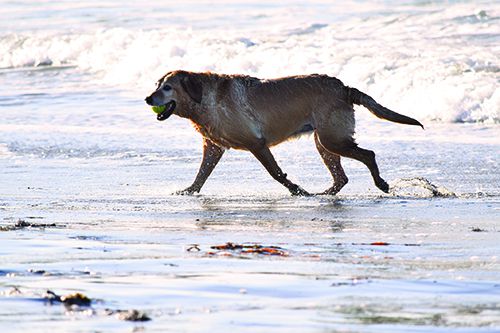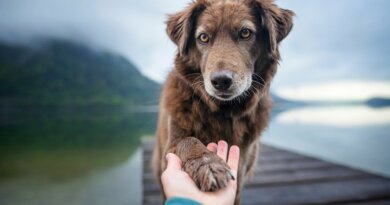Home Care for Your Dog’s Sports Injury
Your active dog begins limping or moving in an unfamiliar way, setting off mental alarms. Is it a sprain? A pulled muscle? Maybe an injured ligament or tendon? And what should you do about it?
First, you should know whether the abnormality is an acute or chronic symptom.
An acute injury is one that flares up quickly, within 24 to 48 hours of the incident that caused it. Acute injuries result from sprains, falls, collisions, and other impacts, and they produce sharp sudden pain, tenderness, redness, swelling, skin that feels hot to the touch, and inflammation.
In contrast, chronic injuries are slow to develop, get better and worse, and cause dull pain or soreness over extended periods. The usual causes of chronic injuries are overuse, arthritis, and acute injuries that were never properly treated.
SIGNS OF PAIN
Sometimes an injury is obvious – the dog cries out in pain, shows a dramatic limp, or can’t move. But noticing subtle symptoms can help prevent more serious problems, so paying attention your dog’s movement and behavior is time well spent. Pain and stress signals include the following:
*Behavior changes:
Avoiding contact with other dogs (play can cause pain).
Spending less or more time than usual with family or sleeping.
Growling or snapping for no apparent reason.
Avoiding routine activities such as getting into the car, climbing stairs, or jumping onto a bed or sofa.
Suddenly becoming hyperactive, unable to rest quietly, panting heavily, pacing, or chewing a body part.
Ignoring training cues, attempting to leave, sniffing the ground in a distracted manner, shutting down and not moving, offering behaviors other than the ones requested, or offering appeasement gestures such as licking, crouching, pawing, rolling over, yawning, or looking away.
*Physical changes:
Refusing meals or treats.
Eliminating more frequently or vomiting.
No longer sitting straight.
Developing hot spots or other skin/coat changes.
Seeming stiff and sore, favoring one leg or one side of the body, moving differently, or displaying other changes in gait or posture.
Heat in the affected area. (Slowly run your hand over the dog’s body and check for changes of temperature.)
The most common canine injuries are not acute, they’re chronic, says Cathy Davis, DVM, a Certified Canine Rehabilitation Therapist, veterinary chiropractor, and veterinary acupuncturist specializing in sports medicine in Helena, Montana. Chronic injuries result from repetitive motion, overuse, and wear and tear. Every dog is a candidate for injury, but those at special risk include overweight dogs, weekend athletes, couch potatoes, dogs with arthritis, older dogs, dogs engaged in search and rescue, and canine athletes (such as dogs competing in flyball, agility, freestyle, disc dog, hunting, field work, dock diving, obedience, weight pulling, dog sledding, and other active sports).
WHAT TO DO
The No. 1 recommendation for canine injuries is rest. Both obvious injuries and subtle microtears take time to heal, especially if they involve ligaments and tendons, which don’t have a blood supply that carries healing nutrients to the injury site. That’s why it’s important to stop hiking, running, playing, or competing as soon as even minor symptoms arise.
“If your dog is suddenly lame, bleeding, or licking a paw excessively,” says Dr. Davis, “check his nails, paw pads, and fur. Grass awns are often found lodged in the skin between the toes. Cuts, stingers, or foreign bodies often affect the pads, and a torn nail can hurt.”
If the injury is serious, take your dog straight to a veterinary clinic, but for minor injuries or when a clinic visit isn’t possible, take your dog home and keep him quiet. Take notes on the changes you notice, starting with the date and time you first saw the problem and describe your dog’s activities at the time. An accurate history of symptoms and treatments will help your veterinarian or other therapist understand and treat the injury.
To document symptoms, do range-of-motion exercises, such as luring your dog with a treat or toy into a turn to the right or left or raising and lowering his head. Daily massage and gentle touch offer clues, too. Does your dog turn away when you stroke or press her shoulder or hindquarters? Does any area feel unusually warm, hard, stiff, tender, or swollen? Touch is one of the fastest ways to discover inflammation, muscle strains, and other discomforts.
“Many minor and acute muscle, tendon, and ligament injuries respond to rest, ice, and massage,” says Dr. Davis. “Resting your pet involves going out on a leash to toilet, and no walks, hikes, running, jumping, stairs, or playing with other animals. If your pet has not improved or gets worse or shows the same symptoms after a few days, see your veterinarian for a proper diagnosis.”
COLD OR HEAT?
Cold is recommended for acute injuries because it reduces swelling and pain. Injured dogs instinctively seek puddles, ponds, streams, and snowbanks in which to stand or lie.
“Everyone says that a bag of frozen peas makes an effective ice pack,” says Dr. Davis, “but that isn’t true. The peas don’t stay cold long enough to do anything.” Cold therapy products for pets are available at pet supply stores, and medical supply companies sell cold packs for sports injuries. The best cold packs contain a gel that stays malleable when frozen, so they can be molded around a dog’s musculature.
To make your own cold packs, place 2 cups water, ½ cup isopropyl (rubbing) alcohol, and 2 tablespoons salt in a self-sealing plastic bag (double-bag to be sure the seal is secure) and freeze.
Because cold restricts circulation and ice left in place for too long can cause complications, wrap any uncovered ice pack with a towel before applying it, remove the pack after 10 to 15 minutes, and wait at least two hours before reapplying. Never apply cold treatments just before exercise, training sessions, or competition.
Heat helps chronic problems like sore muscles, arthritic joints, and old injuries because it stimulates circulation, helps release tight muscles, and alleviates spasms. Heat is not recommended for acute injuries, areas of swelling or inflammation, or for use immediately after exercise.
To make your own warm pack, place 2 cups of raw rice in a sock, tie the sock top, and microwave for 1 minute. The pack will stay hot for 20 minutes. Add a lavender sprig or drop of essential oil for added relaxation. The sock can be reused several times. If you don’t have a microwave, place raw rice on a cookie sheet and preheat the oven to 150°F for 5 to 7 minutes, pour the warm rice into a sock or pouch, check to be sure it’s a safe, comfortable temperature, and apply. Alternatively, pour very warm water on a towel, wring it well, and apply to the area. Reheat as needed.
Never leave a dog unattended when using a warm pack. Always place a towel between the pack and skin to assure proper temperature.
HANDS-ON TECHNIQUES THAT SPEED HEALING
Massage basics are easy to learn, and most dogs enjoy being stroked, kneaded, stretched, and rubbed. Massage helps repair damaged tissue, soothe the patient, restore range of motion, and prevent recurring injuries. Hire a canine massage therapist or learn the fundamentals by reading books or studying videos (see “Dog Massage Instruction,” August 2021.)
Chiropractic adjustments correct the alignment of joints and vertebrae in order to relieve pain, reduce muscle spasms, improve coordination, and enhance overall health (see “Chiropractors for Canines,” March 2008).
Acupuncture can improve or correct musculoskeletal problems such as arthritis, disc disorders, stiffness, and lameness. Acupressure, its close relative, involves activating acupressure points without inserting needles. This can be done with gentle finger pressure or by creating small circles that move the skin clockwise or counterclockwise (see “Truly Healing Touch,” March 2009).
Canine rehabilitation therapists and veterinarians offer a variety of treatments for injuries, including therapeutic exercise, hydrotherapy, shock wave therapy (see “Shock Waves for Arthritis,” May 2008), therapeutic ultrasound, therapeutic laser, PEMF therapy, cryotherapy, orthotics and bracing (see “Canine Knee Injury? Brace Yourself,” December 2020), electrical stimulation, herbal treatments, and energy healing techniques such as Reiki.
Don’t give your dog over-the-counter medication without consulting your veterinarian. “Many human medications may not be tolerated by your pet,” explains Dr. Davis, “or they may cause adverse interactions with your dog’s other medications.”
Even if your dog responds well to pain medication and seems to be fine, continue your veterinarian’s instructions for rest and limited exercise, letting the injury heal completely.
OUNCE OF PREVENTION
It requires attention and effort, but helping your dog avoid injury through preventive measures is time well spent.
One important goal is preventing obesity. “Excess weight leads to excess tension on the tendons, ligaments, and muscles,” says Dr. Davis. “In addition, obesity is an inflammatory condition. Chronic inflammation can lead to degenerative joint disease and a host of other issues throughout the body.” Control your overweight dog’s food intake, reduce her training treats, and prevent family members from giving her extras. Successful canine weight loss is a family affair.
For pets, just like humans, a strong core strength reduces strain on the spine and extremities. A sensible goal is to maintain regular conditioning throughout your dog’s life. “Your dog does not have to be an athlete to train like one,” says Dr. Davis. “There are many online conditioning and sporting groups, and your local kennel club may have recommendations.”
Another preventive strategy is to avoid repeating the same movements over and over. Throwing a tennis ball may be your dog’s favorite activity, but repetition contributes to injury, so alternate ball throwing with activities that involve other movements.
Too-long toenails change the toes’ biomechanics, which affects the alignment and motion of legs and spine, so keep nails trimmed short.
Be sensible about your dog’s schedule. Suddenly switching from couch potato to canine athlete contributes to sprains and strains. Inactive dogs need time and gradually increasing activity to prepare for trail runs, ambitious games of fetch, and other “too much fun” times. And if your dog suffers an injury, be patient. Remember that the passage of time is one of your dog’s best healers.
Using All The Available Tools to Keep Her Dog Together

Dash, a 3-year-old Irish Terrier, was having too much fun last March – and to his owner, Laurie Ekanger in Clancy, Montana, something didn’t look right. He had trouble getting out of the car and climbing steps, was panting more than usual, and wasn’t interested in hiking. Because Dash is usually rambunctious, this was unusual behavior.
Ekanger took Dash to veterinarian Cathy Davis, who uses physical therapy, chiropractic, and acupuncture in her veterinary sports-medicine practice in Helena, Montana. To Dr. Davis, Dash looked like a dog with a soft-tissue injury. “Sprains and strains to ligaments, tendons, and muscles are extremely diverse,” Dr. Davis explains, “but all of them involve microscopic tissue tears. The degree of structural involvement is what determines the treatment.”
Dr. Davis watched Dash walk, took videos of him moving to check for subtle movement abnormalities, and examined his muscles, bones, and joints. “If a dog needs a chiropractic adjustment,” she says, “I give one as I’m going through the exam, and if I feel a trigger point, which is a painful, tense area of muscle tissue, I release it. If I feel heat or inflammation, I use a laser to make repairs at the cellular level with light energy. I work on a pulsed electromagnetic bed, so patients receive PEMF (Pulsed Electromagnetic Frequency) treatments as well.” Dr. Davis used a laser on Dash’s left elbow and prescribed a nonsteroidal anti-inflammatory drug (NSAID) and a week of rest. Dash recovered and resumed his active lifestyle.
In June, Dash spent four days at a boarding kennel with an open-play environment. “I got daily pictures and reports,” says Ekanger. “He had a wonderful time and bounded into the car when we picked him up. But at home he began to limp, favoring his left paw. Two days of rest took care of that symptom, and he was fine until the day after an agility lesson, when he began to favor and lick his left ankle.” This time, Dr. Davis found mild swelling in Dash’s left ankle, gave him another laser treatment, and prescribed an NSAID and another week of rest. Dash has been running and playing as usual since then.




